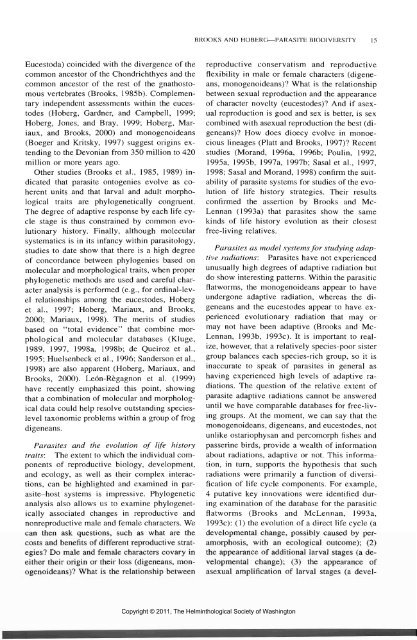Comparative Parasitology 67(1) 2000 - Peru State College
Comparative Parasitology 67(1) 2000 - Peru State College
Comparative Parasitology 67(1) 2000 - Peru State College
You also want an ePaper? Increase the reach of your titles
YUMPU automatically turns print PDFs into web optimized ePapers that Google loves.
Eucestoda) coincided with the divergence of the<br />
common ancestor of the Chondrichthyes and the<br />
common ancestor of the rest of the gnathostomous<br />
vertebrates (Brooks, 1985b). Complementary<br />
independent assessments within the eucestodes<br />
(Hoberg, Gardner, and Campbell, 1999;<br />
Hoberg, Jones, and Bray, 1999; Hoberg, Mariaux,<br />
and Brooks, <strong>2000</strong>) and monogenoideans<br />
(Boeger and Kritsky, 1997) suggest origins extending<br />
to the Devonian from 350 million to 420<br />
million or more years ago.<br />
Other studies (Brooks et al., 1985, 1989) indicated<br />
that parasite ontogenies evolve as coherent<br />
units and that larval and adult morphological<br />
traits are phylogenetically congruent.<br />
The degree of adaptive response by each life cycle<br />
stage is thus constrained by common evolutionary<br />
history. Finally, although molecular<br />
systematics is in its infancy within parasitology,<br />
studies to date show that there is a high degree<br />
of concordance between phylogenies based on<br />
molecular and morphological traits, when proper<br />
phylogenetic methods are used and careful character<br />
analysis is performed (e.g., for ordinal-level<br />
relationships among the eucestodes, Hoberg<br />
et al., 1997; Hoberg, Mariaux, and Brooks,<br />
<strong>2000</strong>; Mariaux, 1998). The merits of studies<br />
based on "total evidence" that combine morphological<br />
and molecular databases (Kluge,<br />
1989, 1997, 1998a, 1998b; de Queiroz et al.,<br />
1995; Huelsenbeck et al., 1996; Sanderson et al.,<br />
1998) are also apparent (Hoberg, Mariaux, and<br />
Brooks, <strong>2000</strong>). Leon-Regagnon et al. (1999)<br />
have recently emphasized this point, showing<br />
that a combination of molecular and morphological<br />
data could help resolve outstanding specieslevel<br />
taxonomic problems within a group of frog<br />
digeneans.<br />
Parasites and the evolution of life history<br />
traits: The extent to which the individual components<br />
of reproductive biology, development,<br />
and ecology, as well as their complex interactions,<br />
can be highlighted and examined in parasite-host<br />
systems is impressive. Phylogenetic<br />
analysis also allows us to examine phylogenetically<br />
associated changes in reproductive and<br />
nonreproductive male and female characters. We<br />
can then ask questions, such as what are the<br />
costs and benefits of different reproductive strategies?<br />
Do male and female characters covary in<br />
either their origin or their loss (digeneans, monogenoideans)?<br />
What is the relationship between<br />
BROOKS AND HOBERG—PARASITE BIODIVERSITY 15<br />
reproductive conservatism and reproductive<br />
flexibility in male or female characters (digeneans,<br />
monogenoideans)? What is the relationship<br />
between sexual reproduction and the appearance<br />
of character novelty (eucestodes)? And if asexual<br />
reproduction is good and sex is better, is sex<br />
combined with asexual reproduction the best (digeneans)?<br />
How does dioecy evolve in monoecious<br />
lineages (Platt and Brooks, 1997)? Recent<br />
studies (Morand, 1996a, 1996b; Poulin, 1992,<br />
1995a, 1995b, 1997a, 1997b; Sasal et al., 1997,<br />
1998; Sasal and Morand, 1998) confirm the suitability<br />
of parasite systems for studies of the evolution<br />
of life history strategies. Their results<br />
confirmed the assertion by Brooks and Mc-<br />
Lennan (1993a) that parasites show the same<br />
kinds of life history evolution as their closest<br />
free-living relatives.<br />
Parasites as model systems for studying adaptive<br />
radiations: Parasites have not experienced<br />
unusually high degrees of adaptive radiation but<br />
do show interesting patterns. Within the parasitic<br />
flatworms, the monogenoideans appear to have<br />
undergone adaptive radiation, whereas the digeneans<br />
and the eucestodes appear to have experienced<br />
evolutionary radiation that may or<br />
may not have been adaptive (Brooks and Mc-<br />
Lennan, 1993b, 1993c). It is important to realize,<br />
however, that a relatively species-poor sister<br />
group balances each species-rich group, so it is<br />
inaccurate to speak of parasites in general as<br />
having experienced high levels of adaptive radiations.<br />
The question of the relative extent of<br />
parasite adaptive radiations cannot be answered<br />
until we have comparable databases for free-living<br />
groups. At the moment, we can say that the<br />
monogenoideans, digeneans, and eucestodes, not<br />
unlike ostariophysan and percomorph fishes and<br />
passerine birds, provide a wealth of information<br />
about radiations, adaptive or not. This information,<br />
in turn, supports the hypothesis that such<br />
radiations were primarily a function of diversification<br />
of life cycle components. For example,<br />
4 putative key innovations were identified during<br />
examination of the database for the parasitic<br />
flatworms (Brooks and McLennan, 1993a,<br />
1993c): (1) the evolution of a direct life cycle (a<br />
developmental change, possibly caused by peramoiphosis,<br />
with an ecological outcome); (2)<br />
the appearance of additional larval stages (a developmental<br />
change); (3) the appearance of<br />
asexual amplification of larval stages (a devel-<br />
Copyright © 2011, The Helminthological Society of Washington
















